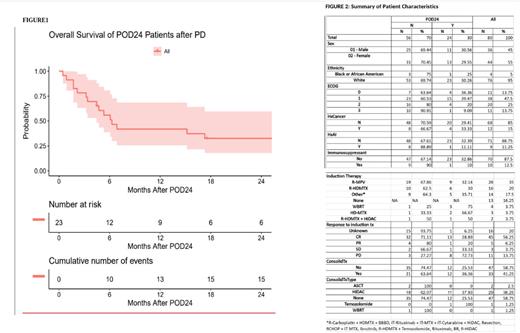INTRODUCTION: Primary CNS lymphoma (PCNSL) is a rare lymphoma subtype. Treatment with whole brain radiotherapy (WBRT) resulted in high response rates but poor overall survival and modern therapy typically involves combination chemotherapy regimens that include rituximab and high dose methotrexate and, in some cases, followed by consolidative chemotherapy such as autologous stem cell transplantation (ASCT). However, there is no standard regimen, and the choice is institutional and/or physician preference. We performed a single institution retrospective study evaluating the outcomes of patients with PCNSL with focus on outcome stratified by POD24.
METHODS: We performed a retrospective analysis of patients with PCNSL at Cleveland Clinic between January 1, 2010 to December 31, 2020, at the Cleveland Clinic. Patients were excluded if there was any evidence of disease outside of the CNS. Progression-free survival (PFS) and overall survival (OS) after diagnosis were estimated using the Kaplan-Meier method and compared by log rank test. OS was estimated for patients with an event within 24 months (POD24) from the time of this event to death or last follow up.
RESULTS: Data from 80 consecutive eligible patients were analyzed with a median follow up of 44 months. The median age at diagnosis was 63 (range 24-87) and 55% were female. Only a small minority of patients were being treated with immunosuppressants at diagnosis (12%). Of the patients receiving induction therapy, 35% received R-MPV, 20% received R-HDMTX, 4% received HD-MTX alone, 4 % received WBRT as a frontline treatment. 16% of patients received no therapy. The overall response rate to induction therapy was 62% (56% CR and 6% PR). The majority of patients did not receive consolidation treatment (59%). Of those who did receive consolidative therapy, non-myeloablative high dose cytarabine was the most frequently used strategy. Thirty-six patients progressed (45%) and of these, the majority (67%) occurred within 24 months of starting therapy. For the entire cohort, the median PFS was 16 months, and the median OS was 32 months. The 1-year and 5-year OS rates were 66% and 34%, respectively. An ECOG performance status of 0 or 1 was associated with significantly improved PFS and OS (p < 0.0001 for both. Median OS after PD for patients with POD24 was 6 months [95% confidence interval (CI) 4-NA] with only 42% alive at 1 year.
CONCLUSION: This large retrospective study evaluating all patients with B-cell NHL PCNSL with extended follow up shows that the majority of progressive events occur within 24 months and is associated with poor outcomes. Rituximab and polychemotherapy regimens are now favored over rituximab and methotrexate alone to improve response rates. Our data show that emphasis on strategies for consolidation such as high dose chemotherapy and autologous transplantation are needed to prevent progression.
Disclosures
Winter:BeiGene: Consultancy; Seattle Genetics: Consultancy; Janssen: Consultancy; ADC Therapeutics: Consultancy; AstraZeneca: Consultancy.


This feature is available to Subscribers Only
Sign In or Create an Account Close Modal